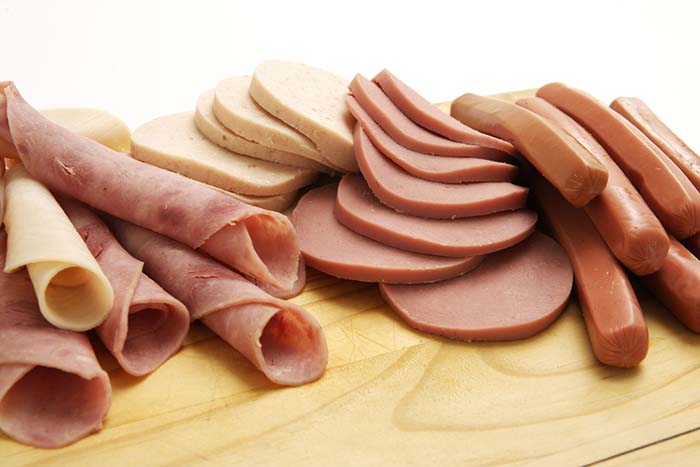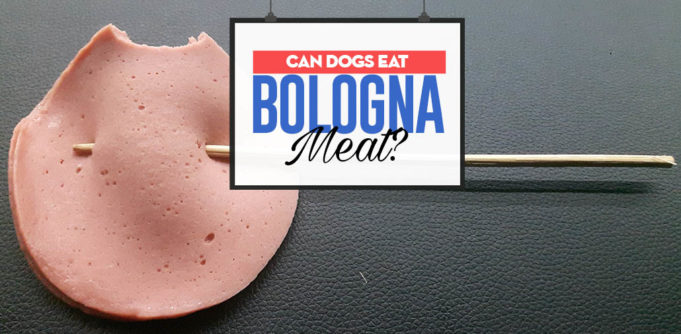Many people make bologna meat a staple in their sandwiches every day, but can dogs eat bologna meat as well, and is bologna meat for dogs safe to consume? What are the benefits of giving bologna sausage to dogs, and are there any side effects? Let's take a look at the evidence and dig deeper.
If you've been wondering, “can I give my dog bologna meat,” the answer is YES – dogs can eat bologna sausage with no problems as long as it's given in moderation. It cannot be a staple in your dog's diet mostly due to some questionable contents in it.
Bologna meat in general is not a healthy or nutritional snack for dogs or humans. However, dogs do love the taste of it and given as an occasional treat, bologna for dogs is totally safe. That being said, there are a few things you should know about this product.
Table of Contents
READ: Can Dogs Eat Oranges?
What is bologna?
Bologna meat or bologna sausage (sometimes referred to as baloney) originated in the Italian city of Bologna, but there it is called mortadella. The most common variety of bologna is a thick sausage sprinkled with fats, pistachios and peppercorns.
We are far more familiar with bologna as a luncheon meat appropriate for sandwiches. In the US, bologna sausage is part of the same category as hot dogs, made as “meat paste.”
This is what American bologna sausage looks like:

Due to the way it's made, American bologna is sometimes referred to as “mystery meat” because it is a combination of meat ingredients turned into a paste. Although the result may be tasty, it’s not filled with the most nutritious ingredients.
Generally, it's best to avoid bologna meat if your goal is a healthy and nutrient-dense diet for your dog. As most other processed meats (pastrami, salami, hot dogs, etc.) it has been modified through many different processes to enhance and preserve the flavor.
Studies have shown that processed meats are not good for people or dogs:
- They increase chance of cancer and cardiovascular disease (1)
- They cause high blood pressure (2) and heart disease (3, 4)
- They are linked to chronic diseases like COPD (5, 6)
- They may cause stomach and bowel cancer (7, 8)
- They contain nitrosamines that increase risk of cancer (9)
- They are high in salt and may cause hypertension and cancer (10, 11, 12)
This is just a very brief look at the science of bologna meat and all other processed meat groups that this sausage belongs to. As you can see, there are plenty of evidence that presents a good reason not to consume bologna meat, even if it's not directly harmful.
But are there any benefits from bologna meat for dogs, and what specifically should dog owners keep in mind if they want to feed bologna meat to dogs? Let's take a closer look.
RELATED: Can Dogs Eat Grapes?
Bologna Meat for Dogs 101
Can Dogs Eat Bologna Meat?
 With all the above in mind, can dogs eat bologna sausage in general? Technically yes, dogs can eat bologna meat and it's not toxic to them, meaning there will be no immediate side effects if a small amount is given to a dog as a treat.
With all the above in mind, can dogs eat bologna sausage in general? Technically yes, dogs can eat bologna meat and it's not toxic to them, meaning there will be no immediate side effects if a small amount is given to a dog as a treat.
However, bologna sausage for dogs should only be given as a rare treat and in strict moderation.
Bologna meat is processed, and is filled with salts and fats. Thus, as the above scientific evidence indicates, it's normally best to avoid this meat altogether.
Here are the most common contents and facts about bologna sausages:
- Usually made of pork, chicken, and beef products
- It has high levels of fat
- Moderate protein amounts
- It's high in calories
- Elevated levels of nitrates
- It's high in sodium
- Little to no vitamins and minerals
- Sometimes has corn syrup
Aside from a little protein in bologna sausages, there are little to no nutritional benefits from giving bologna meat to dogs. It's usually viewed as “soul” food or a cheap way to add meat to your diet, even though it barely resembles real meat.
1 Benefit of Bologna Meat for Dogs
With everything I mentioned above, it's pretty clear that there are no health benefits from giving bologna meat to dogs. However, I feel I need to mention this one small sem-benefit of bologna sausage:
1. Bologna meat provides a moderate level of protein.
Bologna sausages normally contain moderate amounts of protein, usually more than an egg. Protein contains amino acids that your dog’s body needs to build cells and tissue.
Protein is the only benefit that bologna meat can offer your dog. Other food options supply as much if not more protein and are healthier and safer for canines. Ultimately, this small little “benefit” of bologna meat doesn't outweigh the potential side effects.
“So, can I give my dog bologna sausage?”
Yes, technically you can give your dog bologna meat. However, due to its poor nutritional content and high risk of diseases later down the line, it's generally not recommended to feed bologna to dogs.
That said, if your dog has just eaten a piece of bologna by chance, it's not an issue. Bologna meat is not toxic to dogs, and they will digest it with no problems. But it's best to avoid making bologna sausages a staple in your dog's diet.
The Bottom Line: Bologna meat is not toxic to dogs, but it's best to avoid it in your canine's diet due to its low nutritional content and plenty of unhealthy ingredients.
RELATED: 30 Myths That Many Dog Owners Still Believe
7 Potential Side Effects of Bologna Meat for Dogs
(and most other processed meats)

We've already reviewed the many different potential adverse effects of eating processed meats like bologna sausage above, many of which have been proven in studies. Here are a few things to keep in mind in terms of side effects of bologna meat for dogs:
1. The high fat and calorie content in bologna meat is unhealthy for dogs.
Bologna is so high in calories because it has a high fat content, and not the right kind of healthy dietary fat that your dog would benefit from.
Just like hot dogs, bologna is made from low-grade meats, leftovers, lard and other things that you would normally not eat on their own. A two ounce serving of bologna is almost as high in fat as a cup of ice cream.
The consumption of this type of food has been linked to weight gain, obesity as well as many diseases including heart disease, chronic diseases and cancers.
2. Nitrates may cause serious illnesses and cancers in dogs.
Nitrates are the chemical compounds frequently added to processed meats like bologna sausage that give cured meat its pink color and preserve the flavor and smells.
They are also used as preservatives to prevent the growth of harmful bacteria in meat. Naturally occurring nitrate can be beneficial to both humans and dogs. However, nitrates used in processed meats are linked to an increased risk of digestive and bowel cancers.
3. Bologna meat is too high in sodium chloride for dogs.
Processed meats like bologna sausage contain high levels of sodium chloride, otherwise known as table salt, which may be very unhealthy for dogs in high amounts.
Although used to improve flavor, a slightly larger amount of salt can lead to serious illnesses in your dog, like hypertension and heart disease, which has been shown in studies. High sodium levels lead to an elevated risk for stomach ulcers and cancers.
4. Too much bologna meat can lead to pancreatitis in dogs.
Pancreatitis is an inflammation of the dog's pancreas that interferes with its primary functions: to secrete digestive enzymes and dispense insulin to balance blood sugar.
Pancreatitis can occur in mild forms or can become a severe, life-threatening condition for your dog. The symptoms of pancreatitis are vomiting, diarrhea, fever, abdominal pain, and lethargy. It's a very common condition, mostly because people give bad foods to pets.
Unfortunately, even dogs who recover from canine pancreatitis have a high chance of a recurrence of this illness, and are harmed for life.
5. Gastrointestinal distress is a potential issue for the dog.
Processed meats like bologna sausage which is full of unhealthy fats and too much salt are not what your dog is accustomed to or biologically prepared to digest.
Too much bologna meat can cause stomach upset, stomach pain, vomiting, or diarrhea. This, of course, would be the least of your problems if giving too much of this food.
6. Corn syrup is an additive in some bologna meat.
Some bologna sausage manufacturers add corn syrup into the mix to make the meat taste even better, and it's another very serious health concern for dogs.
Corn syrup comes from corn starch, and too much of this kind of highly processed sugar can lead to serious diseases like heart disease and diabetes in dogs.
7. BHA and BHT may cause serious health problems in dogs.
BHA (butylated hydroxyanisole) and BHT (butylated hydroxytoluene) are synthetic antioxidants that are used as preservatives in some processed meats, like bologna meat.
Research has found possible links between BHA and BHT and liver, kidney, and thyroid problems in both humans and animals. These “fake” antioxidants may also have an impact on neurological functions, and are associated with the development of cancer forms.
Summary:
Can My Dog Eat Bologna Meat?
 In conclusion, dogs can eat bologna meat sausages because they are not toxic to them and won't cause any immediate health problems (unless given too much).
In conclusion, dogs can eat bologna meat sausages because they are not toxic to them and won't cause any immediate health problems (unless given too much).
That said, while bologna is okay for dogs, it is far from the best snack option for your pup. Bologna meat is full of processed stuff and peppered with high levels of fat, nitrates, salt, and sugar, which makes it also high in calories and less than ideal treat for dogs.
Studies have shown that continued consumption of processed meats like bologna sausage may lead to multiple illnesses, diseases, and cancers, so it's best to avoid it altogether.
References
READ NEXT: 15 Ways to Make Sure Your Dog Gets Enough Good Quality Meat













